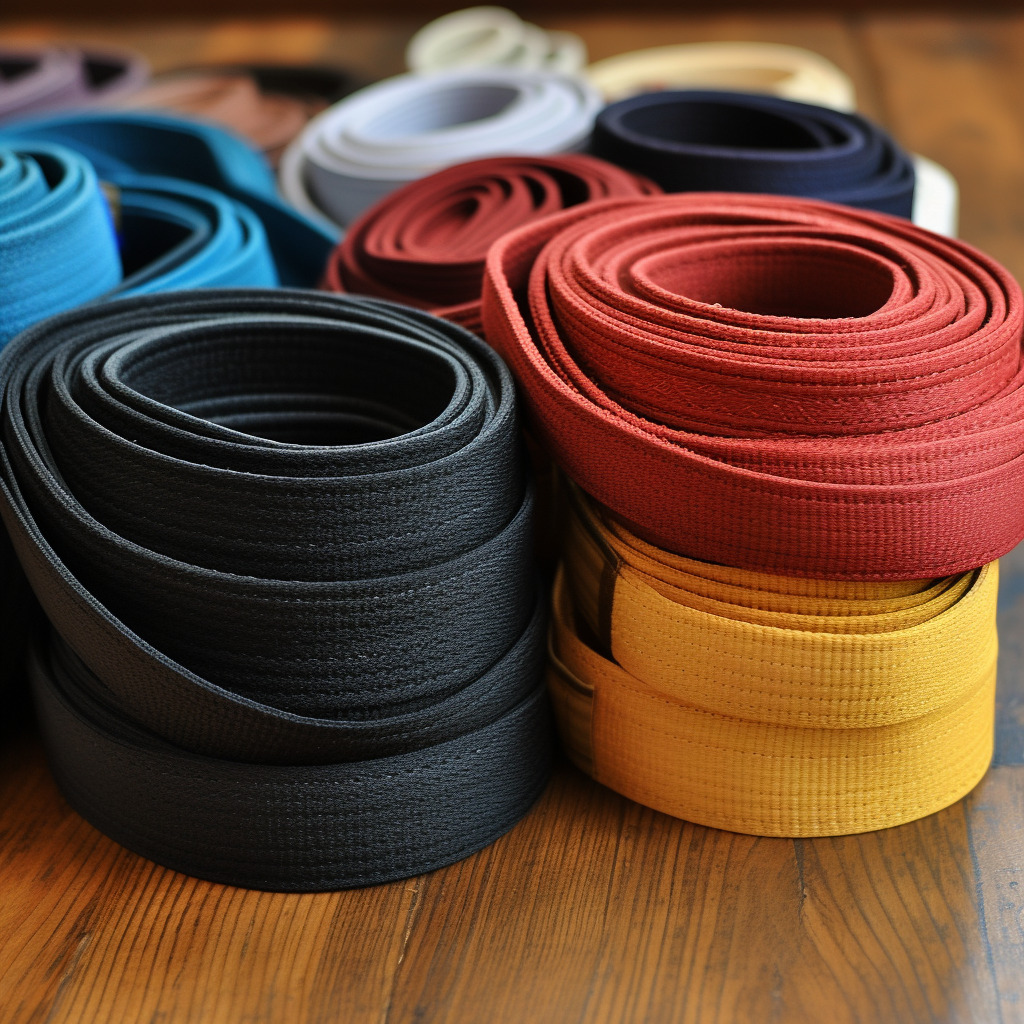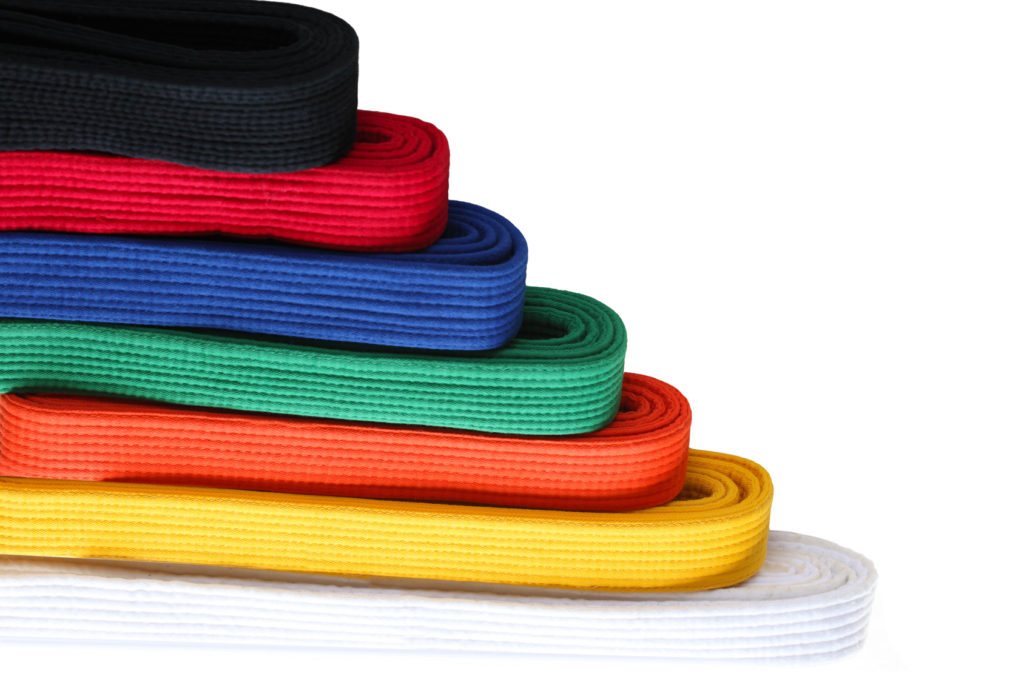In unserem Beitrag stellen wir Euch die Gürtelfarben im Karate sowie die Einteilung im Wettkampf vor. Denn beim Karatetraining tragen die Teilnehmer Gürtel in unterschiedlichen Farben. Diese geben an, welchen Ausbildungsstand der Karateka bislang erreicht hat. Bei Wettkämpfen wird die Unterscheidung über Gewichts- und Altersklassen getroffen.
In 30 Sekunden das Wichtigste:
- Es gibt neun Schüler (weiß bis braun) und zehn Meistergrade (alle schwarz bzw. weiß-rot)
- Um aufzusteigen muss eine Prüfung absolviert werden, darin werden Techniken, Trainingsabfolgen abgefragt bzw. Übungskämpfe bestritten.
- Der Gürtel hält den Anzug zusammen und wird auf traditionelle Weise gebunden
- Alle KWON-Budo-Gürtel sind aus 100%
- fester Baumwolle und mehrmals gesteppt.
- Es gibt sie in den Längen 200, 220,

Karate Gürtel Reihenfolge: Schüler- und Meistergrade
| Gürtelfarbe | Prüfungsinhalt |
| Weißer Gurt | Die Karate Prüfung zum 9. Kyū, dem Weißgurt, enthält grundlegende Techniken und ist die einzige Prüfung, welche übersprungen werden kann. Sie dient als Zwischenstufe, überwiegend für Kinder, um den Einstieg in Kihon und Kata zu erleichtern und enthält nur 6 Techniken sowie eine einfache Kata namens Taikyoku Shodan. Im Kumite müsst Ihr einen Fauststoß des Partners auf zwei Arten abwehren können. |
| Gelber Gurt | Die meisten von Euch werden mit der Prüfung zum Gelbgurt, dem 8. Kyū, beginnen. Hier erwarten Euch einige Einzeltechniken sowie eine neue Fußposition im Kihon und die Kata Heian Shodan. Das Kumite bleibt unverändert. |
| Orange Gurt | Der 7. Kyū mit dem orangefarbenen Gürtel bildet das Ende der Unterstufe. Diese Karate Prüfung enthält im Kihon eine erste Kombination und die Kata Heian Nidan. In der Kumite Prüfung müsst Ihr nun auch die ersten Fußtritte abwehren können. |
| Grüner Gurt | Der 6. Kyū trägt den grünen Karate Gürtel und muss überwiegend Kombinationen erlernen, welche langsam die Einzeltechniken verdrängen. Weiterhin müsst Ihr die Kata Heian Sandan beherrschen, eine neue Variante des Kumite lernen und einen neuen Prüfungsteil, die Partnerübung zum Freikampf, vorführen. Diese gehört von nun an zum Prüfungsprogramm dazu. |
| 1. Blauer Gurt | Der 5. Kyū trägt je nach Verband den violetten oder blauen Gürtel (manchen Verbänden ist das auch egal) und besteht im Kihon ausschließlich aus Kombinationen. Die benötigte Kata nennt sich Heian Yondan und im Kumite findet Ihr die Sonderform, dass der Partner, welcher den ersten Angriff ausführt, auch den Treffer landet. Ab dem 5. Kyū kann der Prüfer alle vorher gelernten Kata auf Wunsch vorführen lassen. |
| 2. Blauer Gurt | Der zweite blaue Gürtel, der 4. Kyū, muss für seine Prüfung den aus Filmen bekannten Rückwärtstritt Ushiro-Geri lernen und die Kata Heian Godan beherrschen. Das Kumite bleibt unverändert und im Freikampf werden nun erstmals Tritte eingesetzt. |
| 1. Braune Gurt | Der erste braune Karate Gürtel, der 3. Kyū, muss die Kata Tekki Shodan beherrschen und erstmals das Bunkai (die Anwendung einer Kata am Gegner) der Kata Heian Godan vorführen können. Im Kumite sind von hier an keine Kontertechniken mehr vorgegeben, sondern von Euch frei zu wählen. |
| 2. Braune Gurt | Der 2. Kyū, weiterhin braun, benötigt die Kata Bassai Dai und deren Bunkai zum Bestehen. Das Kumite sollte inzwischen mit deutlich mehr Geschwindigkeit und Improvisation ausgeführt werden können. |
| 3. Braune Gurt | Der 1. Kyū ist der letzte braune Gürtel und bildet das Ende der Oberstufe. Hier könnt Ihr erstmals Eure Kata selbst wählen, wobei Euch einige zur Auswahl vorgegeben werden. Diese müsst Ihr laufen können und im Bunkai anwenden. |
| 1. Schwarze Gurt | Karate Meister darf sich erstmals nennen, wer die Prüfung zum 1. Dan abschließt, wobei das Hintergrundwissen an Bedeutung gewinnt. Hier steigt nicht nur die Schwierigkeit des Kihon enorm an, sondern auch der Wert der Kata und des Bunkai. Von größter Wichtigkeit ist es für einen Karate Dan, den Sinn hinter den Techniken einer Kata korrekt zu erkennen. Eine Kata darf der Anwärter selbst wählen, die er erst läuft und anschließend im Bunkai vorführt. Es darf jedoch nicht die Gleiche sein, die er bereits für den 1. Kyū wählte. Das Kumite bleibt unverändert. |
| 2. Schwarze Gurt | Die Karate Prüfung zum 2. Dan ist die letzte Prüfung, deren Programm noch weitestgehend vorgeschrieben ist. Ihr müsst diverse Techniken im Kihon beherrschen, eine Kata nach eigener Wahl laufen und analysieren und bekommt 2 weitere vom Prüfer genannt. Das Kumite bleibt unverändert. |
| 3. Schwarze Gurt | Ab der Prüfung zum 3. Dan bestehen die Prüfungsinhalte im Kihon zum Teil aus von Euch gewählten Techniken, bei denen Ihr Eure Stärken demonstrieren könnt und zum Teil aus vom Prüfer Gewählten. Bei der Kata bleibt das Verhältnis einer selbst Gewählten zu zwei vom Prüfer ausgesuchten Kata bestehen, wobei der angehende Karate Meister hier den Ablauf einer Kata erklären muss. Das Kumite besteht ausschließlich aus vom Prüfer vorgegebenen Techniken. |
| 4 – 9. Schwarze Gurt | Die Prüfungen der Dan Grade 4 bis 9 kennzeichnen sich dadurch, dass der praktische Teil der Prüfung schrumpft, während der theoretische Teil, das Wissen um die Anwendung der einzelnen Kata, weiter an Bedeutung gewinnt. Dass Fehler bei der Ausführung der Techniken in diesen Prüfungen nicht mehr toleriert werden, sollte sich als selbstverständlich erweisen. In den oberen Schwarzgurt-Graden spielt auch das Alter eine Rolle und diese Ehre kommt nur erfahrenen Lehrern mit überdurchschnittlichen Leistungen zuteil. |
| 10. Schwarze Gurt | Die oberen Schwarzgurte unterscheiden sich beim japanischen und chinesischen System. Ein 10. Dan wird nur im japanischen System vergeben, dort endet die Ausbildung mit dem 9. Dan. Ab dem 7. Dan darf man sich den Title „Großmeister“ aneignen. |
Einteilungen beim Karate
Es existieren zwei Arten der Einteilung.
- In erster Linie werdet Ihr als Karateka danach streben, Euren individuellen Grad zu erhöhen. Es existieren 9 Schülergrade und 10 Meistergrade, welche Ihr durch das Ablegen einer Karate Prüfung erreichen könnt. Dieser jeweilige Grad wird durch den farbigen Karate Gürtel gekennzeichnet und gibt Aufschluss darüber, wie lange und wie intensiv Ihr in der Vergangenheit bereits trainiert habt.
- Die andere Einteilung ist die Bildung von Karate Gewichtsklassen und Altersklassen bei Wettkämpfen, wobei der individuelle Grad unbeachtet bleibt. Hier geht es vor allem darum, Unterschiede in Gewicht und Größe möglichst klein zu halten, um einen fairen Wettkampf zu gewährleisten.
Karate Gürtel kaufen
Tabelle zur Größe
| Körpergröße | Gürtellänge |
| ca. 1,50 m | 2,30 m bis 2,50 m |
| 1,50 m bis 1,75 m | 2,50 m bis 2,70 m |
| 1,75 m bis 1,90 m | 2,70 m bis 3,00 m |
| über 1,90 m | 3,00 m bis 3,30 m |

FAQ zu Karate Gürtel
Im Wesentlichen hat der Gürtel (jap. Obi) zwei Funktionen. Er dient dazu, die Anzugjacke ordentlich zusammen zu halten und lässt an der Farbe den Ausbildungsstand des Trägers erkennen.
Der Karategürtel ist nicht nur das schließende Element des Karateanzugs, sondern signalisiert auch euren Kenntnisstand über die Kampfsportart. Hier findet Ihr Antworten auf häufige Fragen rund um Karategürtel und was es beim Kauf zu beachten gibt. In einem anderen Beitrag findet ihr einen Überblick zu den Farben und notwendigen Prüfungen.
- Boxsack Basics: Findet den perfekten Boxsack für euer Heimtraining - 23. November 2023
- Mobbing am Arbeitsplatz: Tipps & Hilfestellungen für Betroffene - 15. November 2023
- Wohnung & Haus effektiv vor Einbruch schützen: 10 Tipps & FAQ - 3. November 2023
Update: 2025-07-01 / Affiliate Links / Bilder von der Amazon Product Advertising API
